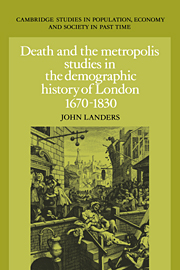Book contents
- Frontmatter
- Contents
- List of figures and maps
- List of tables
- Preface
- Acknowledgements
- Part I EIGHTEENTH-CENTURY LONDON AND ITS VITAL REGIME
- Part II THE LEVEL OF MORTALITY
- Part III DIMENSIONS OF LONDON'S EPIDEMIOLOGICAL REGIME
- 6 The seasonality of mortality
- 7 The instability of mortality
- 8 Spatial variations in mortality
- 9 Conclusion
- Appendices
- Bibliography
- Index
- Cambridge Studies in Population Economy and Society in Past Time
6 - The seasonality of mortality
Published online by Cambridge University Press: 05 November 2011
- Frontmatter
- Contents
- List of figures and maps
- List of tables
- Preface
- Acknowledgements
- Part I EIGHTEENTH-CENTURY LONDON AND ITS VITAL REGIME
- Part II THE LEVEL OF MORTALITY
- Part III DIMENSIONS OF LONDON'S EPIDEMIOLOGICAL REGIME
- 6 The seasonality of mortality
- 7 The instability of mortality
- 8 Spatial variations in mortality
- 9 Conclusion
- Appendices
- Bibliography
- Index
- Cambridge Studies in Population Economy and Society in Past Time
Summary
The importance of cause of death patterns for the understanding of mortality in the past has been widely acknowledged, but has not generated a corresponding body of demographic literature on the subject. The diseases of eighteenth-century London have, however, attracted some attention from contemporary and later writers alike who have generally concentrated on two conditions that seem to have worsened in the course of the century: smallpox and typhus. The first of these was only too familiar to contemporaries and it is one of the few instances of a cause of death category in the Bills which can be reliably equated with a condition known to twentieth-century medicine.
Smallpox, as we have seen, appears to have been a universal childhood affliction in the capital. It was particularly prevalent in the third quarter of the century, accounting for 10 per cent of all recorded burials, but from the 1780s its share began to decline substantially, and the disease was responsible for little more than 5 per cent of burials in the years 1800–24. The earlier proportions are more likely to understate the relative significance of the disease than to exaggerate it. A certain number of victims of ‘fulminating smallpox’ may have been wrongly classified, but more important is the apparent role of smallpox morbidity in enhancing the risks of death from other conditions.
The term ‘typhus’, by contrast, was not used until mid-century and then only as a generic label to distinguish a range of ‘slow’, or ‘nervous’, fevers from the ‘inflammatory’, or ‘choleric’, conditions described by writers such as Sydenham in the preceding century (Risse 1985).
- Type
- Chapter
- Information
- Death and the MetropolisStudies in the Demographic History of London, 1670–1830, pp. 203 - 241Publisher: Cambridge University PressPrint publication year: 1993
- 2
- Cited by

